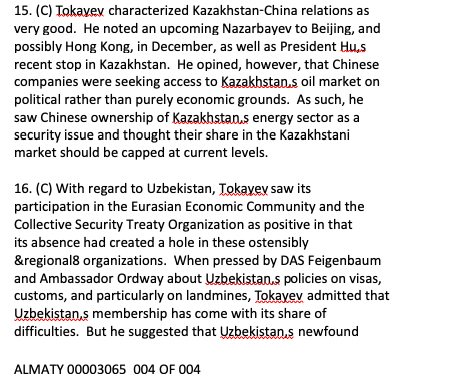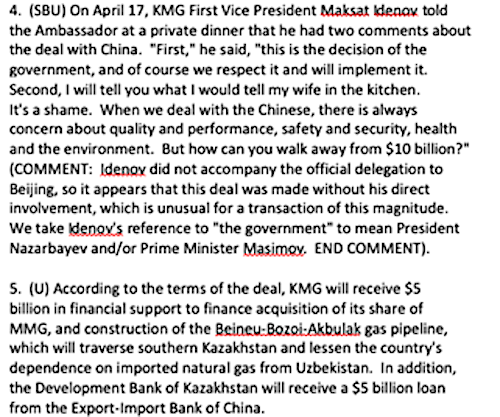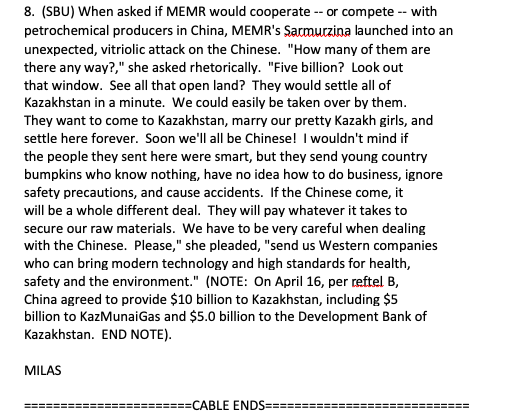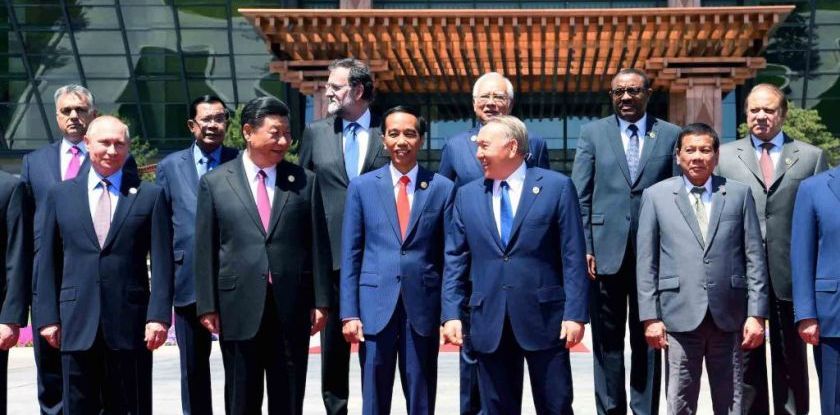Why was the Kazakh elite afraid of the Chinese business invasion ten years ago and how does it relate to the current protests in the Western Kazakhstan? An answer to this question one can find in an article published on the new media-resource KZ.MEDIA.
Below, is the text of this article.
On September 3, hundreds of the Zhanaozen citizens gathered in the city’s central square again and spoke against “the building of 55 Chinese enterprises in Kazakhstan”. Governor of the Mangistau Region Serikbay Trumov met with the protestors and urged calm. On that day, the protests in support of the Zhanaozen citizens were held in Nur-Sultan, Shymkent and Aktobe.

Anti-Chinese protests in Zhanaozen. Video snapshot
Then followed a large-scale propaganda campaign aimed to sooth the Chinese factor in the Kazakh economy. Simultaneously, they underscored the irrational nature of these fears.
Meanwhile, a comparative analysis of dozens of the projects completed by China in different countries shows that a lot of these concerns are justified. What is especially interesting is that many of these conclusions were made in Kazakhstan ten years ago and were reflected in the conversation between the Kazakh officials and the US diplomats.
The Chinese Road to a Single Belt
In April of the current year, the Center for a New American Security (CNAS) published a report called GRADING CHINA’S BELT AND ROAD in which it draws the first conclusions on the realization of the Chinese “One Belt One Road” initiative launched in 2013.
The authors believe that the Chinese initiative is not simply an integrated economic plan of creating an intertwined world financed by China, but an instrument for pursuing China’s geopolitical ambitions based on the growing authoritarianism. Therefore, the countries that once welcomed the Chinese investments have started to register the downsides of this “new world”.
The CNAS report consists of the overview of ten cases of the completion of the Chinese projects in different countries. The comparative analysis of these cases has allowed the authors to arrive at the following conclusions.
- Erosion of national sovereignty: Beijing has obtained control over select infrastructure projects through equity arrangements, long-term leases, or multi-decade operating contracts.
- Lack of transparency: Many projects feature opaque bidding processes for contracts and financial terms that are not subject to public scrutiny.
- Unsustainable financial burdens: Chinese lending to some countries has increased their risk of debt default or repayment difficulties, while certain completed projects have not generated sufficient revenue to justify the cost.
- Disengagement from local economic needs: Belt and Road projects often involve the use of Chinese firms and labor for construction, which does little to transfer skills to local workers, and sometimes involve inequitable profit-sharing arrangements.
- Geopolitical risks: Some infrastructure projects financed, built, or operated by China can compromise the recipient state’s telecommunications infrastructure or place the country at the center of strategic competition between Beijing and other great powers.
- Negative environmental impacts: Belt and Road projects in some instances have proceeded without adequate environmental assessments or have caused severe environmental damage.
- Significant potential for corruption: In countries that already have a high level of kleptocracy, Belt and Road projects have involved payoffs to politicians and bureaucrats.
Each of the projects analyzed had at least three problems registered in the list above.
One may write the authors’ worries off based on the ideological nature of the Center whose task is to warn on the risks for the US national security. However, the thing is that, many of the risks cited in the report were known to the Kazakh officials ten years ago when the first results of the Chinese economic expansion had started to appear in the country.
The Prophetic Telegrams
The real perception of the Chinese economic expansion by the Kazakh officials was registered in the State Department telegrams a collection of which was published online by the efforts of Julian Assange’s team.
Recall that the telegrams were made public in 2011 reflecting the sentiments of the beginning of the 21st century. They looked much more catastrophic than the report released in 2019. However, these telegrams (contrary to the report) were never intended for wide readership.
Video of the “current times” anti-Chinese protests in Kazakhstan
The attitude towards the Chinese economic expansion in Kazakhstan had been forming gradually. In 1990s, the society did not yet experience any fear; the Chinese investors were the last of the citizens’ worries. Apart from that, at that moment, the Soviet stereotypes about China as a third world country that may only threaten others with the massive relocation and not with buying out the land and other national assets were still relevant
Therefore, when CNPC bough a share in two oil fields – Kenkiyake and Zhanazhol in 2009 and then purchased the controlling stake in Aktobemunaygas that owned the fields in the Aktobe region for $4.3 bln, these events went practically unnoticed.
The change happened in the mid-2000s then the country started earning money and had a better confidence in the future. In 2005, Chinese National Petroleum Corporation (CNPS) bought PetroKazakhstan having won over LUKOIL in this transaction. And at the end of 2006, Chinese CITIC Group bought 100% of the shares in National Energy Company registered in Canada for $1.9 bln.
As we can see, in both cases they were not talking about privatizing the Kazakh assets as well as there was no alternative Kazakh investors wanted to challenge the foreigners.
The symptoms of dissent started to appear in the society. The then Minister of Energy and Mineral Resources Baktykozha Izmukhambetov was eager to provide administrative support to this sentiment. According to WikiLeaks, the Minister wanted to employ emergency measures in order not to allow for the transaction to take place at all.
Izmukhambetov’s motives were also easily defined by geographical subtext. A native of Western Kazakhstan and Aday tribe, and Ufa Oil Institute’s graduate, Baktykozha Salakhatdinovich had traveled the entire path of an oiler’s career – from a driller to a minister. Judging by how the events in Western Kazakhstan are unfolding today, Izmukhambetov was not just expressing his own position but the sentiment of the entire Western Kazakhstan.
Back then, the Ministry led by Izmukhambetov suggested changing the resource legislature; the changes were to limit foreign investments in the oil and gas sectors of the country.
Since all these changes were of a general nature and, therefore, were to affect all foreign investors, the Government had to improvise and explain the real goal of the limitations privately. WikiLeaks quoted an unnamed Deputy of the Minister of Finance who advised the Americans not to worry for the suggested changes were specifically directed against Chinese investments.
Here is an interesting Kasym-Zhomart Tokayev’s personal admission. In that same 2006, in his conversation with US diplomats, he pointed out the political nature of the interest of the Chinese companies that were seeking access to the Kazakh oil market. In his private talks with American diplomats, Kasym-Zhomart Tokayev discussed the intention to freeze the status quo in regard to the share of the Chinese investments in the oil sector.

A fragment of a Dispatch of the US Ambassador to Kazakhstan. Source: Wikileaks
It is quite possible that the future President was simply playing a diplomatic game with the American colleagues. The thing is that, in reality, the Kazakh authorities were simply trying to bump up the prices involving the Russian oilers in the game. According to the Kommersant journalists, CNPC and CITIC obtained the assets with the direct participation of the Kazakh authorities who had been helped to raise the prices by the Russian companies that, in the midst of an auction, would suddenly come up with offers that raised the price forcing CNPC and CITIC to agree to the Kazakh terms.
Strictly speaking, back then everyone was playing the prices up without taking much notice of the origin of the money. For instance, in 2006, well-known “technocrat” Grigoriy Marchenko being Chairman of the Management Board of Halyk Bank offered the American diplomats to participate in the auction.
“Try and outbid the offer of the Chinese who are ready to pay 25% more than the other buyers”, - cites his words one of WikiLeaks’ telegrams.
Marchenko did not believe in the possibility of the legislative limitations and admitted that, in time, the Chinese would own a significant part of the market. Given the fact that the banker had always worked closely with Timur Kulibayev, it was not just theoretical knowledge.
In 2009, the Chinese investors bought Mangistaumnaygs and then 11% of the shares in KazMunaiGas Exploration Production. All these were directly tied to the Nazarbayev family and this circumstance destroyed all the hopes on freezing the status quo in regard to the Chinese investments in the Kazakh oil sector.
The 2008 financial crisis played significantly in favor of the “cash” supporter, even within the highest circles of political establishment.
“With the start of the economic crisis, China has become the most attractive partner for Kazakhstan” – says an analytical note signed by the then US Ambassador to Kazakhstan Richard Hoagland.
“But how can you walk away from $10 billion?” – ыфны in 2009 Senior Vice President of KazMunaiGas Maksat Idenov commenting on the Mangistaumunaigas sale transaction.

A fragment of the Dispatch of the US Ambassador to Kazakhstan. Source: Wikileaks
By the way, the KasMunaiGas Exploration Production management learned about the transaction from the newspapers. One of the managers even complained to the Americans having described his own state as “shocked”.
As a rule, the dialogue partners of the US diplomats when talking about the Chinese investments in the oil sector characterized this expansion as the realization of the Chinese authorities’ state strategy. But sometimes, in these dialogues, real tragic undertones could be heard. For instance, as a result of the leak, Kazakhstan’s modern history got enriched by a commentary of Raushan Sarmuzina of the Ministry of Energy and Natural Resources who said to the American diplomats:
“How many of them are there any way? Five billion? Look out the window. See all that open land? They would settle all of Kazakhstan in a minute. We could easily be taken over by them. They want to come to Kazakhstan, marry our pretty Kazakh girls and settle here forever. I wouldn’t mind if the people they sent here were smart, but they sent young country bumpkins who know nothing, have no idea how to do business, ignore safety precautions and cause accidents”.
This conversation happened more than ten years ago.

A fragment of the Dispatch of the US Ambassador to Kazakhstan. Source: Wikileaks
Today, the past worries of the elite have become the people’s ideology. However, today there are no more worries in the elite’s public statements (granted, there are no more leaks of the secrets dispatches, either). On the other hand, all the information channels are now promoting the idea that “there is nothing to worry about and everything is under control”. And the people’s concerns, in the process of such brainwashing, tend to turn into paranoia.
In view of this, it is worthy to recall yet another passage from the WikiLeaks publication. It presents an opinion of a person who stands very far from the people of Kazakhstan.
Here is how a departmental director of the Baker Hughes company describes the modus operandi of the Chinese managers in the Kazakh oil business.
“They typically buy a medium-sized oil field, something productive and valuable, but "under the radar." According to Arnaly, the Chinese then bring in their own workers, their own suppliers, and their own equipment. They do not hire very many local staff or subcontractors and show no interest in developing the professional skills or capacity of local staff. They also do not share information about operations, even with their own staff and subcontractors. Arnaly said CNPC's projects are tightly controlled by Chinese management and are run "almost like military
operations. There is a checklist for everything and all decisions follow a clear chain of command that goes straight to Beijing."
Here is an opinion of a PriceWaterhouseCooper tax service partner who, in the 2000s, had already had experiences working with the Kazakh business.
“Before a transaction, Chinese clients "deal above board and play by the rules." They pay promptly, hire top talent, and conduct thorough due diligence to understand the risks and costs of acquiring property, registering as a legal entity, hiring local and expatriate staff, and purchasing subsoil licenses. However, according to Fowler, after the transaction is over, "they close the circle tight." Fowler said her Chinese clients then bring in their own people, systems, procedures, and equipment. She said that she does not have much information about what happens operationally at this stage, because her Chinese clients are more closed and opaque after closing a deal”.
Thus, the ex-patriots did not have any paranoia but a clear understanding that the Chinese investments are much closer to the European colonization of the 19th century than to the modern business-processes. And, in this sense, their admissions that were not intended for the public eye coincide with the conclusions of the authors of the report.
The Economy of Chinese Investments
Over the course of the last decade, Chinese investors have continued to actively explore the Kazakh economy. All the warnings and supposed limitations regarding the Chinese investments in the Kazakh oil sector have been forgotten. The country’s oil and gas sector has been blanketed by a series of transactions with the Chinese companies performing the role of the buyer.
Today, Chinese investors are exploring new spaces and conquering new heights. According to the statistical data, here are the five most attractive sectors for the Chinese investors:
- transportation and storing;
- mining industry;
- finances and insurance;
- construction;
- processing industry.
In terms of their scale, the Chinese investments are significantly behind the European ones. All the more so since the lion share of the latter lies in the re-investing of the Kazakh residents’ funds (from, say, Netherlands). On the other hand, China has high growth rates. Its investments grow more than 30% every year.
Supposedly, it is the Chinese investments that should be able to fill the investment gap in the country. Currently, the investments/GDP ratio constitutes 17% but, according to Akorda’s plans, this indicator is to grow up to 25-30% - the levels demonstrated by the South-Asian states during the economic catching up period.
BBC Video on the Anti-Chinese Protests in Kazakhstan
One should note that the main feature of the Chinese investments is the high level of the reinvestment of the profits received in Kazakhstan. This shows the strategic nature of the Chinese investments in Kazakhstan. The common problem of all the Chinese investments in Kazakhstan is their obvious connection with the creation of the EEU. This can be also seen from the desire to invest the funds in transportation and storing.
In other words, these investments are intended not for the Kazakh market but for the common Eurasian market which, in fact, turns Kazakhstan into Russia’s hostage (keeping in mind that Russia is the biggest market on the EEU territory).
Any attempt to leave the union may lead to the total exodus of the investments. And this is exactly what the CNAS report’s authors worn us on – on the geopolitical consequences of the Chinese investments.
This is particularly important since the main and clear characteristics of the Chinese investment program in Kazakhstan in the existence of the integrated strategy of living in the Eurasian space. And the success of this strategy may signify an economic colonization of this space.




